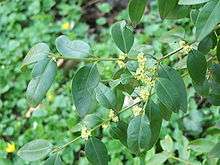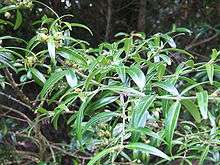Buxus
| Buxus | |
|---|---|
 | |
| Common Box Buxus sempervirens | |
| Scientific classification | |
| Kingdom: | Plantae |
| (unranked): | Angiosperms |
| (unranked): | Eudicots |
| Order: | Buxales |
| Family: | Buxaceae |
| Genus: | Buxus L. |
| Species | |
|
About 70 species; see text | |





Buxus is a genus of about 70 species in the family Buxaceae. Common names include box (majority of English-speaking countries) or boxwood (North America).[1]
The boxes are native to western and southern Europe, southwest, southern and eastern Asia, Africa, Madagascar, northernmost South America, Central America, Mexico and the Caribbean, with the majority of species being tropical or subtropical; only the European and some Asian species are frost-tolerant. Centres of diversity occur in Cuba (about 30 species), China (17 species) and Madagascar (9 species).
They are slow-growing evergreen shrubs and small trees, growing to 2–12 m (rarely 15 m) tall. The leaves are opposite, rounded to lanceolate, and leathery; they are small in most species, typically 1.5–5 cm long and 0.3-2.5 cm broad, but up to 11 cm long and 5 cm broad in B. macrocarpa. The flowers are small and yellow-green, monoecious with both sexes present on a plant. The fruit is a small capsule 0.5-1.5 cm long (to 3 cm in B. macrocarpa), containing several small seeds.
The genus splits into three genetically distinct sections, each section in a different region, with the Eurasian species in one section, the African (except northwest Africa) and Madagascan species in the second, and the American species in the third. The African and American sections are genetically closer to each other than to the Eurasian section.[2]
Selected species
- Europe, northwest Africa, Asia
- Buxus austro-yunnanensis (Yunnan Box; southwest China)
- Buxus balearica (Balearic Box; Balearic Islands, southern Spain, northwest Africa)
- Buxus bodinieri (China)
- Buxus cephalantha (China)
- Buxus cochinchinensis (Malaysia)
- Buxus colchica (Georgian Box; western Caucasus; considered also a syn. of B. sempervirens)
- Buxus hainanensis (Hainan Box; China: Hainan)
- Buxus harlandii (Harland's Box; southern China)
- Buxus hebecarpa (China)
- Buxus henryi (Henry's Box; China)
- Buxus hyrcana (Caspian Box; Alborz, eastern Caucasus; considered also a syn. of B. sempervirens)
- Buxus ichangensis (China)
- Buxus latistyla (China)
- Buxus linearifolia (China)
- Buxus megistophylla (China)
- Buxus microphylla (Japanese Box; Korea, China; long cultivated in Japan)
- Buxus mollicula (China)
- Buxus myrica (China)
- Buxus papillosa (western Himalaya)
- Buxus pubiramea (China)
- Buxus rivularis (Philippines)
- Buxus rolfei (Borneo)
- Buxus rugulosa (China, eastern Himalaya)
- Buxus rupicola (Malaysia)
- Buxus sempervirens (Common Box or European Box; western and southern Europe, except far southwest)
- Buxus sinica (Chinese Box; China, Korea, Japan)
- Buxus stenophylla (China)
- Buxus wallichiana (Himalayan Box; Himalaya)
- Africa, Madagascar
- Buxus acuminata (Africa: Zaire; syn. Notobuxus acuminata)
- Buxus calcarea (Madagascar endemic)
- Buxus capuronii (Madagascar endemic)
- Buxus hildebrantii (eastern Africa: Somalia, Ethiopia)
- Buxus humbertii (Humbert's Box; Madagascar endemic)
- Buxus itremoensis (Madagascar endemic)
- Buxus lisowskii (Congo)
- Buxus macowanii (Cape Box; eastern and northern South Africa)
- Buxus macrocarpa (Madagascar endemic)
- Buxus madagascarica (Madagascan Box; Madagascar, Comoros)
- Buxus monticola (Madagascar endemic)
- Buxus moratii (Madagascar, Comoros)
- Buxus natalensis (Natal Box; eastern South Africa; syn. Notobuxus natalensis)
- Buxus obtusifolia (eastern Africa; syn. Notobuxus obtusifolia)
- Buxus rabenantoandroi (Madagascar endemic; syn. B. angustifolia GE Schatz & Lowry non Mill.)
- Americas
- Buxus aneura (Cuba)
- Buxus bartletii (Central America)
- Buxus brevipes (Cuba)
- Buxus citrifolia (Venezuela)
- Buxus crassifolia (Cuba)
- Buxus ekmanii (Cuba)
- Buxus excisa (Cuba)
- Buxus heterophylla (Cuba)
- Buxus imbricata (Cuba)
- Buxus lancifolia (Mexico)
- Buxus macrophylla (Central America)
- Buxus mexicana (Mexico)
- Buxus muelleriana (Cuba)
- Buxus olivacea (Cuba)
- Buxus pilosula (Cuba)
- Buxus portoricensis (Puerto Rico)
- Buxus pubescens (Mexico)
- Buxus rheedioides (Cuba)
- Buxus vahlii (Vahl's Box or Smooth Box; Puerto Rico; syn. B. laevigata)
Uses
Cultivation
Box plants are commonly grown as hedges and for topiary.
In Great Britain and Mainland Europe box is subject to damage from caterpillars of Diaphania perspectalis which can devastate a box hedge within a short time. This is a recently introduced species first noticed in Europe in 2007 and in the UK in 2008 but spreading. There were 3 UK reports of infestation in 2011, 20 in 2014 and 150 in the first half of 2015.[3]
Wood carving

Owing to its fine grain it is a good wood for fine wood carving, although this is limited by the small sizes available. It is also resistant to splitting and chipping, and thus useful for decorative or storage boxes. Formerly, it was used for wooden combs. As a timber or wood for carving it is "boxwood" in all varieties of English.
Owing to the relatively high density of the wood (it is one of the few woods that are denser than water), boxwood is often used for chess pieces, unstained boxwood for the white pieces and stained ('ebonized') boxwood for the black pieces, in lieu of ebony.[4]
The extremely fine endgrain of box makes it suitable for woodblock printing and woodcut blocks, for which it was the usual material in Europe.
High quality wooden spoons have usually been carved from box, with beech being the usual cheaper substitute.
Boxwood was once called dudgeon, and was used for the handles of dirks, and daggers, with the result that such a knife was known as a dudgeon. Although one "in high dudgeon" is indignant and enraged, and while the image of a dagger held high, ready to plunge into an enemy, has a certain appeal, lexicographers have no real evidence as to the origin of the phrase.
Musical instruments
Due to its high density and resistance to chipping, boxwood is a relatively economical material, and has been used to make parts for various stringed instruments since antiquity.[5] It is mostly used to make tailpieces, chin rests and tuning pegs, but may be used for a variety of other parts as well. Other woods used for this purpose are rosewood and ebony.
Boxwood was a common material for the manufacture of recorders in the eighteenth century, and a large number of mid- to high-end instruments made today are produced from one or other species of boxwood. Boxwood was once a popular wood for other woodwind instruments, and was among the traditional woods for Great Highland bagpipes before tastes turned to imported dense tropical woods such as cocuswood, ebony, and African blackwood.[6]
See also
References
- ↑ Only the wood as a material is "boxwood" in British English
- ↑ von Balthazar, M.; Endress, P. K.; Qiu, Y.-L. (2000). "Phylogenetic relationships in Buxaceae based on nuclear internal transcribed spacers and plastid ndhF sequences". International Journal of Plant Science 161 (5): 785–792. doi:10.1086/314302.
- ↑ Invasive caterpillar 'could spread in UK'
- ↑ "Chess Piece Materials". The Chess ZoneDiaphania perspectalis.
- ↑ See Theocritus Idyll 24.110, where Heracles is taught to play a boxwood lyre.
- ↑ Joshua Dickson (9 October 2009). The Highland bagpipe: music, history, tradition. Ashgate Publishing, Ltd. pp. 50–. ISBN 978-0-7546-6669-1. Retrieved 29 April 2011.
External links
- Box / Royal Horticultural Society
- American Boxwood Society
- Revision of the genus Buxus in Madagascar (pdf file)
| Wikispecies has information related to: Buxus |
| Wikimedia Commons has media related to Buxus. |
| Wikisource has the text of the 1911 Encyclopædia Britannica article Boxwood. |